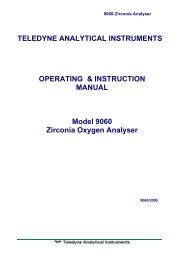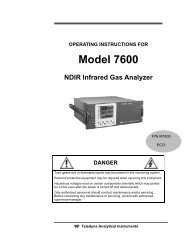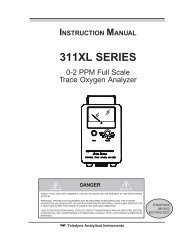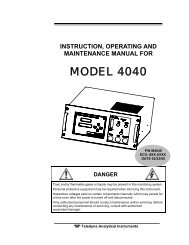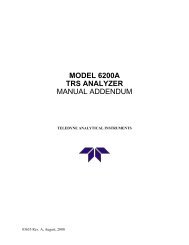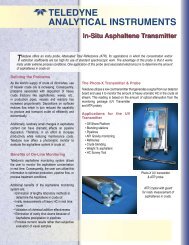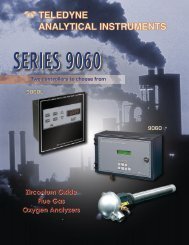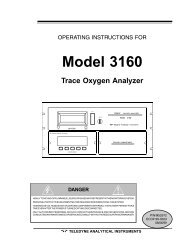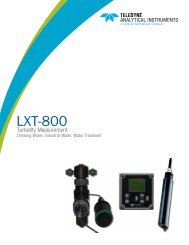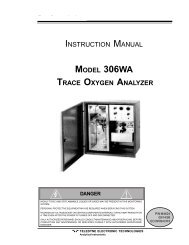Nickel-Cadmium batteries
Nickel-Cadmium batteries
Nickel-Cadmium batteries
Create successful ePaper yourself
Turn your PDF publications into a flip-book with our unique Google optimized e-Paper software.
Page 1 of 6MATERIAL SAFETY DATA SHEETSANYO BatteriesSANYO Energy2055 Sanyo Ave.San Diego, CA 92154Date of Preparation: 1/5/02Telephone No.: (619) 661-4888www.sanyo<strong>batteries</strong>.comIn case of emergency contact:CHEMTREC at (800) 424-9300Section I — Product IdentificationProduct Name:<strong>Nickel</strong> <strong>Cadmium</strong> BatteryTrade Name: CADNICA Nominal Voltage: 1.2VChemical System: <strong>Nickel</strong>/<strong>Cadmium</strong> Designated for Recharge:___ X Yes ___NoSection II — Hazardous IngredientsIMPORTANT NOTE: The battery cell should not be opened or exposed to heat because exposure to the followingingredients contained within could be harmful under some circumstances.Chemical Name CAS No. % 1 PEL TLV<strong>Cadmium</strong> 7440-43-9 11-26 0.005 TWA 2 0.05 TWA<strong>Cadmium</strong> hydroxide 21041-95-2 11-26 0.005 TWA 0.05 TWA<strong>Nickel</strong> (powder) 7440-02-0 8-17 1 TWA 1 TWA<strong>Nickel</strong> hydroxide 12054-48-7 5-12 1 TWA 1 TWAPotassium hydroxide 1310-58-3 < 3 2 Ceiling 2 CeilingNylon N/A < 2 N/A N/ASteel N/A 12-13 N/A N/AOther N/A < 1 N/A N/ATotal 100Notes:1. Concentrations vary depending on the state of charge or discharge.2. TWA is the time weighted average concentration over an 8-hour period.Section III — Physical DataThe product is a manufactured article as described in 29 CFR 1910.1200. The battery cell is contained in a hermeticallysealedcase, designed to withstand temperatures and pressures encountered during normal use. As a result, during normaluse, hazardous materials are fully contained inside the battery cell. However, if exposed to a fire, explosion, extreme abuse,misuse, or improper disposal that results in breaching of the battery cell case, hazardous materials may be released. Thefollowing physical data relating to the hazardous materials contained within the battery cell are provided for the user' sinformation. (Also see Section IV — Fire and Explosion Hazards, and Section VIII — Precautions for Safe Handling and Use.)The information and recommendations set forth are made in good faith and believed to be accurate as of the date ofpreparation. SANYO ENERGY CORP. makes no warranty, expressed or implied, with respect to this information anddisclaims all liabilities from reliance on it.
Page 2 of 6<strong>Cadmium</strong>: Melting point (°F): 610 Boiling point (°F): 1,407% Volatile by Volume: Vapor Pressure (mm Hg):Evaporation Rate: Vapor Density (Air =1):Specific Gravity (H 2O): 8.65 @77¡FSolubility in Water: InsolubleAppearance and Odor: Silver-white, blue-tinged, lustrous metal<strong>Cadmium</strong>Hydroxide: Melting Point (°F): Boiling Point (°C):% Volatile by Volume: Vapor Pressure (mm Hg):Evaporation Rate: Vapor Density (Air =1):Specific Gravity(H 2O): 4.79Solubility in Water: Practically insolubleAppearance and Odor: Powder<strong>Nickel</strong>Powder: Melting point (°F): 2,831 Boiling point (°F): 5,134% Volatile by Volume: Vapor Pressure (mm Hg):Evaporation Rate: Vapor Density (Air =1):Specific Gravity (H 2O): 8.90Solubility in Water: InsolubleAppearance and Odor: Powder<strong>Nickel</strong>Hydroxide: Melting point (°F): * Boiling Point (°F):% Volatile by Volume: Vapor Pressure (mm Hg):Evaporation Rate: Vapor Density (Air = 1):Specific Gravity (H 2O):Solubility in Water: InsolubleAppearance and Odor: Apple green powder* Note: decomposes above 392¡F into NiO and H 2O.PotassiumHydroxide: Melting point (°F):* Boiling Point (°F):% Volatile by Volume: Vapor Pressure (mm Hg):Evaporation Rate: Vapor Density (Air =1):Specific Gravity (H 2O):Solubility in Water: Soluble in 0.9 part water, 0.6 part in boiling waterAppearance and Odor: White or slightly yellow* Note: Potassium hydroxide is present as a liquid or paste and acts as the electrolyte in the battery cell.The information and recommendations set forth are made in good faith and believed to be accurate as of the date ofpreparation. SANYO ENERGY CORP. makes no warranty, expressed or implied, with respect to this information anddisclaims all liabilities from reliance on it.
Page 3 of 6Section IV - Fire and Explosion Hazard DataFlash point: NA Lower Explosive Limit: NA Upper Explosive Limit: NAExtinguishing Media: Any class of extinguishing medium may be used on the <strong>batteries</strong> or their packing material.Special Fire Fighting Procedures: Exposure to temperatures of above 212°F can cause evaporation of the liquid content ofthe potassium hydroxide electrolyte resulting in the rupture of the cell. Potential for exposure to cadmium fumes during fire;use self-contained breathing apparatus.Section V - Health Hazard DataThreshold Limit Values: See Section IIEffects of a Single (Acute) Overexposure:Inhalation:During normal use inhalation is an unlikely route of exposure due to containment of hazardous materials within thebattery case. However, should the <strong>batteries</strong> be exposed to extreme heat or pressures causing a breach in thebattery cell case, cadmium dusts and fumes may be emitted. Inhalation of cadmium dusts or fumes may causethroat dryness, respiratory irritation, headache, nausea, vomiting, chest pain, extreme restlessness and irritability,pneumonitis, and bronchopneumonia. In the case of high concentration exposures (e.g., above 1 to 5 mg/m 3 duringan eight hour period) death may occur within several days after the exposure.Ingestion:If the battery case is breached in the digestive tract, the electrolyte may cause localized burns. Ingestion ofcadmium compounds may result in increased salivation, choking, nausea, persistent vomiting, diarrhea, abdominalpain, anemia, tenesmus, and kidney dysfunction.Skin Absorption:No evidence of adverse effects from available data.Skin Contact:Exposure to the electrolyte contained inside the battery may result in chemical burns. Exposure to nickel may causedermatitis in some sensitive individuals.Eye Contact:Exposure to the electrolyte contained inside the battery may result in severe irritation and chemical burns.Carcinogenicity:<strong>Cadmium</strong> and nickel have been identified by the National Toxicology Program (NTP) as reasonably anticipated to becarcinogens. U.S. EPA classified cadmium as a "B1" probable human carcinogen. The International Agency forResearch on Cancer (IARC) recommended that cadmium be listed as a "2A" probable human carcinogen, and theAmerican Conference of Governmental Industrial Hygienists (ACGIH) has proposed listing cadmium as an A2carcinogen.The information and recommendations set forth are made in good faith and believed to be accurate as of the date ofpreparation. SANYO ENERGY CORP. makes no warranty, expressed or implied, with respect to this information anddisclaims all liabilities from reliance on it.
Page 4 of 6Other Effects of Repeated (Chronic) Exposure: Repeated overexposures to cadmium may result in lung cancer; lung, kidney, and liver dysfunction; skeletal disease(e.g., osteoporosis) and reproductive toxicity. Chronic overexposure to nickel may result in cancer; dermal contactmay result in dermatitis in sensitive individuals.Medical Conditions Aggravated by Overexposure: A knowledge of the available toxicology information and of the physical and chemical properties of the materialsuggests that overexposure in unlikely to aggravate existing medical conditions.Emergency and First Aid Procedures:Swallowing: Do not induce vomiting. Seek medical attention immediately.Skin: If the internal cell materials of an opened battery cell comes into contact with the skin, immediately flush with waterfor at least 15 minutes.Inhalation: If potential for exposure to cadmium or nickel fumes or dusts occurs, remove immediately to fresh air and seekmedical attention.Eyes: If the contents from an opened battery comes into contact with the eyes, immediately flush eyes with watercontinuously for at least 15 minutes. Seek medical attention.Section VI - Health Hazard DataThe <strong>batteries</strong> are stable under normal operating conditions.Hazardous polymerization will not occur.Hazardous decomposition products: oxides of cadmium and nickel.Conditions to avoid: heat, open flames, sparks, and moisture.Potential incompatibilities (i.e., materials to avoid contact with): The battery cells are encased in a non-reactive container;however, if the container is breached, avoid contact of internal battery components with acids, aldehydes, and carbamatecompounds.Section VII - Health Hazard DataSpill and leaks are unlikely because cells are contained in an hermetically-sealed case. If the battery case is breached, donprotective clothing that is impervious to caustic materials and absorb or pack spill residues in inert material. Dispose of as ahazardous waste in accordance with applicable state and federal regulations. Resultant spill residues may be characterizedas D002 (caustic) and D006 (cadmium) pursuant to the federal Resource Conservation and Recovery Act (RCRA). SeeSection IV for response to fires or explosions.The information and recommendations set forth are made in good faith and believed to be accurate as of the date ofpreparation. SANYO ENERGY CORP. makes no warranty, expressed or implied, with respect to this information anddisclaims all liabilities from reliance on it.
Page 5 of 6Section VIII - Safe Handling and Use (Personal Protective Equipment)Ventilation Requirements:Respiratory Protection:Eye Protection:Gloves:Not required under normal use.Not required under normal use.Not required under normal use.Not required under normal use.Section IX- Precautions for Safe Handling and UseStorage:Store in a cool place, but prevent condensation on cell or battery terminals. Elevated temperatures may result inreduced battery life. Optimum storage temperatures are between -31°F and 95°F.Mechanical Containment:If there are special encapsulation or sealing requirements, consult your SANYO Energy Corp. representative aboutpossible cell hazard precautions or limitations.Handling:Accidental short circuit will bring high temperature elevation to the battery as well as shorten the battery life. Be sureto avoid prolonged short circuit since the heat can burn attendant skin and even rupture the battery cell case.Batteries packaged in bulk containers should not be shaken. Metal covered tables or belts used for assembly of<strong>batteries</strong> into devices can be the source of short circuits; apply insulating material to assembly work surface.Soldering/welding:If soldering or welding to the case of the battery is required, consult your Sanyo Energy Corp. representative forproper precautions to prevent seal damage or external short circuit.Charging:This battery is designed for recharging. A loss of voltage and capacity of <strong>batteries</strong> due to self-discharge duringprolonged storage is unavoidable. Charge battery before use. Observe the specified charge rate since higher ratescan cause a rise in internal gas pressure which may result in damaging heat generation or cell rupture and orventing.Section X- Recycling and DisposalSANYO encourages battery recycling. Our <strong>Nickel</strong> <strong>Cadmium</strong> <strong>batteries</strong> are recyclable through the Rechargeable BatteryRecycling Corporation's (RBRC) Charge Up to Recycle! Program. For information call 1-800-8-BATTERY or see theirwebsite at www.rbrc.org. Ni-Cd <strong>batteries</strong> must be handled in accordance with all applicable state and federal laws andregulations.The information and recommendations set forth are made in good faith and believed to be accurate as of the date ofpreparation. SANYO ENERGY CORP. makes no warranty, expressed or implied, with respect to this information anddisclaims all liabilities from reliance on it.
Page 6 of 6DO NOT INCINERATE or subject battery cells to temperatures in excess of 212°F. Such treatment can vaporize the liquidelectrolyte causing cell rupture. Incineration may result in cadmium emissions.Section X- Recycling and DisposalSANYO sealed <strong>Nickel</strong> <strong>Cadmium</strong> <strong>batteries</strong> are considered to be "dry cell" <strong>batteries</strong> and are not subject to dangerous goodsregulation for the purpose of transportation by the U.S. Department of Transportation (DOT), the International Civil AviationAdministration (ICAO), the International Air Transport Association (IATA) or the International Maritime Dangerous Goodsregulations (IMDG). The only DOT requirement for shipping <strong>Nickel</strong> <strong>Cadmium</strong> <strong>batteries</strong> is Special Provision 130 which states:"Batteries, dry are not subject to the requirements of this subchapter only when they are offered for transportation in amanner that prevents the dangerous evolution of heat (for example, by the effective insulation of exposed terminals)." IATArequires that <strong>batteries</strong> being transported by air must be protected from short-circuiting and protected from movement thatcould lead to short-circuiting.<strong>Nickel</strong> <strong>Cadmium</strong> <strong>batteries</strong> are classified as a D006 hazardous waste because of the presence of cadmium. This waste codeis assigned because of toxicity, not corrosiveness. These <strong>batteries</strong> do not meet the definition of a corrosive waste.The information and recommendations set forth are made in good faith and believed to be accurate as of the date ofpreparation. SANYO ENERGY CORP. makes no warranty, expressed or implied, with respect to this information anddisclaims all liabilities from reliance on it.





